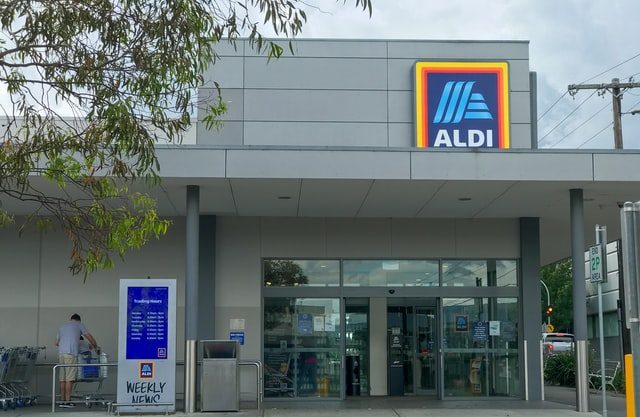Suppose you ask people to recall the first brand that comes to mind while online shopping; the answer would unanimously be Amazon. Similarly, when you ask them to recognize a brand name in the offline retail space, the chances are that the answer would be Walmart. These two are often known as the Big Daddies of the retail world (online and offline).
So, when the CEO of Walmart, Greg Foran (2014 – 2019), uses adjectives like “fierce,” “clever,” and “good” when talking about a competitor he admires, these words are not being used about Amazon but rather for Aldi, you sit up and notice.
A grocery business that started in a small town in Germany is today a giant in the retail world with almost 12,000 stores globally. In 2021, Aldi Group’s net sales amounted to just under 134 billion U.S. dollars, a 15.3 percent growth compared to the previous year.
So, what has made Aldi such a force to reckon with?
Before we understand Aldi’s business model and pricing approach, it makes sense to delve into its history. So, where and how did it all begin?
It started with two brothers obsessed with Frugality
After World War II, brothers Theo and Karl Albrecht decided to expand their family’s grocery business from a small-town Essen in Germany. They were pretty clear from early on that they would grow their business and do better than the competition by providing the best prices to their customers.
To do that, the brothers knew that they had to keep their costs low, and hence they were mindful of every little expense at their store. In fact, Theo was switching off the store’s lights in the daytime and taking copious notes on every deal. They also kept the store design to a bare minimum. These principles of the brothers continue to remain the foundation of Aldi to date.
However, the union between the brothers did not last. A dispute in 1961 on whether Aldi should sell cigarettes or not led to the brothers splitting the business into two: Aldi Nord (North Germany) and Aldi Sud (South Germany). Funnily enough, the area that divides the Aldi Nord and Aldi Sud regions in Germany is known as the ‘Aldi Equator.’
Even though the Albrecht brothers passed away, the two businesses remain separate. They operate in 18 countries between the two chains and are often known as just Aldi, irrespective of whether it is Aldi Nord or Aldi Sud. Together the two Aldi companies are the eighth biggest retailer in the world.
Aldi operates with the motto: “the best quality at the lowest price.”, and its 203,000 employees around the world live this motto every day.
Aldi’s business model of keeping prices low
There are three key components of Aldi’s business model that help the brand keep low prices: Low Operating Cost, High Margin through Private brands & Limited SKUs. Let’s understand each one in detail.
1. Low Operating Costs:
One of the big reasons for Aldi to be able to keep its prices low is by deploying tactics that keep its operating costs as low as possible. These include:
- Essential Customer Experience Only: If you are looking for a delightful customer experience, then maybe you should remove Aldi from your itinerary because keeping the customer experience to a bare minimum is part of Aldi’s strategy to keep its costs low.
This means that Aldi customers are expected to go through a few inconveniences: change to rent a shopping cart, paper, and plastic bags at a fee and packing your groceries. As a result, Aldi does not need to have employees or their time going in retrieving shopping carts as the customer is incentivized/penalized if they do not return the cart. This practice is not new as supermarkets in Europe have been doing this for years, but the American customers find this an inconvenience from Aldi.
- Smart Design Principles: Aldi employs several key design details that maximize efficiency at checkout, too. Aldi puts supersized barcodes on many of its products and prints them on multiple sides. This makes scanning relatively easy and quick. Once the billing is done, the cashier drops the groceries directly into the shopping cart. Aldi doesn’t waste time bagging groceries. It is left to the customers to bag their purchases, and each bag comes at a fee.
Much of the Aldi store merchandise is put up in their original cardboard shipping boxes rather than individually. This saves a lot of employee time, which otherwise would go in stocking shelves with individual products.
- Lower Real Estate: Aldi does not carry as many SKUs as its competitors. Hence, it can keep its store size limited to 12,000 square feet on average compared to 178,000 square feet for Walmart and 145 000 square feet for Costco. The benefit is that its returns per square foot are much higher, and there is less inventory storage, refilling, ordering, and cleaning. As a result, Aldi stores do not need to keep as much staff as their competitors.
- Employees do more than one role: Aldi does not follow the conventional approach like other supermarkets of dividing labor as per roles – cashiers, clerks, operators, etc. At Aldi, employees are cross-trained to do various jobs at the store. Aldi also does not want its staff to answer calls, so it does not publicly share its phone numbers. As a result, quite often, an Aldi store might just have three to five employees in a store, saving them significant money.
All these savings are passed on to customers as discounts or lower prices.
2. High Margins through Private Brands:
90% of Aldi’s portfolio in its stores comes from private labels. This helps them keep their marketing and distribution costs low and gives them flexibility on pricing and margins. In fact, the products and packaging of some of these private labels look pretty similar to the big brands. So do not be surprised if you find a ‘Tandil’ laundry detergent that reminds you of the ‘Tide’ brand.
3. Limited SKUs:
Instead of providing its customers a wide range and aisles of products, Aldi carries only about 1,400 SKUs per store compared to the 40,000 traditional supermarkets carry and 100,000 Walmart supercenters hold. This allows Aldi to have a much faster turnaround of its inventory and helps the customers to make choices faster.
USA: Exploiting The Retail Playground
Even though Aldi is from Europe, knowing the potential of the USA, Aldi Sud has been quite aggressively expanding its base and now has 2,100+ stores spread across 35 states of the country. It has ambitions to have 2,500 stores by the end of 2022, becoming America’s third-largest supermarket chain behind Walmart and Kroger. Illinois has 201 Aldi stores, which is 9% of all Aldi stores across the United States.
Aldi as a strong competitor
One of the biggest mistakes retail chains have made in many different markets is dismissing Aldi’s entry and expansion and not considering it a significant threat to their own business.
Some of them were naïve enough to think that Aldi’s pricing and business model is different from theirs will cater to another segment of customers. This is where they were wrong, and as a result, countries like the USA, Hungary, Ireland, Switzerland, and United Kingdom are places where Aldi has really taken a massive chunk of the market, and the grocers realized this too late.
Aldi not only caters to the low- or mid-income shoppers but also targets the wealthy shoppers. Walmart’s previous CEO, Greg Foran, marveled that he saw so many BMWs and Mercedes in the parking lot of the Aldi store he visited in Australia once. In fact, luxury cars like Jaguar and Tesla Model X are often seen in the parking lots of Aldi stores in the USA.
Aldi has noticed this profile of shoppers as well, and it has smartly ramped up its portfolio and offer by keeping exotic items like brioche from France, Irish cheese, imported items, organic products, pastas from Italy, and much more, which not only helps it to get the high-income shopper but also allows it to earn high margins.
Aldi’s Marketing strategy of connecting with the millennials shoppers
Purpose, Private Brands, Great Marketing
Today’s Millennial and Gen-Z shoppers are much more mindful of the products they buy and more than the brand name; what matters to them are the authenticity of ingredients, the purpose behind the company, and of course, low prices and convenience. Aldi’s reliance on private labels ticks all these boxes and helps them win that set of consumers.
100% of ALDI-exclusive chocolate bars and chocolate confectionery are from sustainable sources, and all of its coffee will be sustainably sourced by 2022.
Aldi understands society and its customers’ needs and keeps their priorities at the forefront. It has several eco-friendly initiatives. ALDI has also been recognized by the EPA (Environmental Protection Agency) for its record-breaking green efforts. The retail giant is dedicated to sustainable business practices while delivering high-quality products and affordable prices.
We believe in acting with integrity and are dedicated to reducing our environmental impact. We’re committed to reducing, reusing and recycling waste, increasing energy efficiency, decreasing our carbon footprint and improving our green building standards across all of our stores and operations.
Aldi’s Website On Environment
In fact, Aldi has a robust Corporate Responsibility Program that comprises of five main areas:
- Employee Appreciation
- Supply chain responsibility
- Resource conservation
- Social commitment
- Dialogue promotion
If you thought that a low-priced chain would not be doing great marketing, let me tell you that Aldi’s ad was crowned 2021’s most effective Christmas ad. Research done by Kantar declared Aldi’s ad of reimagining Charles Dickens’ ‘A Christmas Carol,’ featuring Kevin the Carrot and new character Ebanana Scrooge, as the Christmas ad that would most likely deliver on long and short-term measures for the brand.
These are the perfect recipe to keep the millennials and Gen-Z customers hooked to the chain and coming back for more.
Building Fan Following
With such a business model, you would expect customers not to be delighted with an Aldi experience other than the price benefits. Contrary to expectations, Aldi scores much higher on customer satisfaction surveys than Walmart and other supermarket chains.
In fact, as per Bain & Company, Aldi has one of the highest NPS of ~45 (Net Promoter Scores), which is an excellent indication of how likely customers are going to promote and advocate the brand to others. To give you a perspective, Walmart has an NPS of 16.
Walmart is known for its EDLP or Everyday Low Pricing. However, such is the aura of Aldi that every time a new Aldi opens up, especially in the USA, it results in hundreds of people flocking to the opening as the prices are sometimes even lower than Walmart.
This aura is not limited to people interested in Aldi’s low prices. Such is the cult following of Aldi that there is a fan blog called Aldi Nerd (run by a stay-at-home mom of three kids), and there are people who love to buy Aldi Nerd merchandise. The community has 1.4 Mn members on Facebook.
Unchartered Territories
Aldi opened its first store in China only in 2019 and, to date, has a meager presence of 6 stores in the entire country where retail and e-commerce are part and parcel of everyday living. Aldi has not even made an in-roads into the Indian market as yet.
So other than the frontiers that Aldi is crossing every year, there are still two huge markets that the retail chain has not even tapped into. Aldi’s business model shows you the brand’s potential and why all retail brands should continue watching their shoulder as soon as they see the presence of Aldi in their vicinity.

